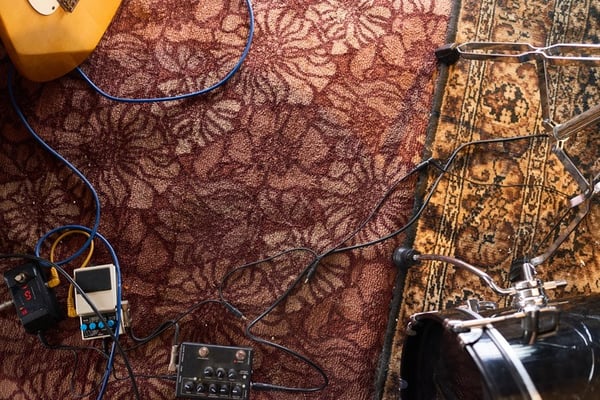Tips for Soundproofing Your Practice Space
If you're a musician, at some point during your career, you've probably struggled to find a good place to practice.
It's not only hard to find a spot suitable for you, but it's also hard to find a place that won't bother everyone else around you.
If your roommate is trying to study for an exam the next morning, the last thing they want to hear is you playing away at your saxophone. If your significant other had a long day at work, they probably don't want to hear your guitar amp turned up to 11.
A quiet rehearsal space is a godsend for a player looking for a place to practice their art.
After all, instruments are designed and set up to produce beautiful tones, as well as the volume that can project to the back of a concert hall.
You could take precautionary steps like use a mute, but that will alter the tone, and you want to be able to hear yourself playing at full throttle to master your performance-level technique.
You could play your electric guitar or bass quietly or invest in an electronic drum set, but are these the best options?
Below are a few tips that can help you create a quieter rehearsal space without driving your family and friends (and neighbors) crazy.
Table of Contents
What Are The Options?
Your goal is to create a room that doesn't produce a lot of reverberation that enables you to hear your instrument without ambient effects.
You'll need to minimize the number of reflective surfaces that allow sound waves to bounce around.
Carpet flooring is best, but if you have a hardwood floor, you should lay down a rug or a sound-absorbing material.

Below are five of the most popular soundproofing treatments.
- Soundboard: These are a laminate composed of several layers of acoustic-grade plasterboard, mass-loaded vinyl, closed-cell foam, and more mass-loaded vinyl. You can place them over your existing drywall or ceiling to create an effective sound barrier.
- Latex wall liners: Rolls of latex can be attached to your walls or ceiling. When a sound wave hits the center of the latex-covered area, it travels to the edge and then back to the center. The sound wave is canceled along the way.
- Acoustic foam: These are lightweight panels constructed of rows of wedge shapes that can reduce echoes. They are available in a variety of sizes and colors and are highly effective at absorbing the high- and mid-range frequencies produced by violins and violas.
- Acoustic panels: These are often made of foam, mineral wool, or fiberglass enclosed in decorative fabric. These panels can be scattered along a wall or ceiling to absorb sound waves and reduce reflection. With these, you don't need to cover a wall completely to get the benefit.
- Acoustic blankets: These are similar in appearance to large moving blankets, but they are constructed of acoustic-grade insulation sewn into a fire-retardant fabric. They're effective at absorbing sound and relatively easy to install.
Budget

Being completely honest, this is likely going to get expensive. You don't want to use cheap or fly-by-night materials that can be ineffective, messy, or even a fire hazard.
Several excellent online companies sell commercial-grade materials at reasonable prices. And their customer service departments will help find the best solution for your needs.
Acoustic wall tiles can be on the cheaper side, but if you're looking for studio acoustic foam or an acoustic blanket it can become rather pricey.
Before you begin your project, you need to be realistic about how much you can spend before you get started. Check out soundproofing material costs on Amazon here.
Less is More
You don't need to worry about eliminating all of the sounds. Reducing the noise emitted from a room by just 10 decibels will create the perception of a 50 percent reduction on the part of an outside listener.
A 20-dB reduction of the sound level will bring the perceived sound level down by 75 percent. By comparison, a normal conversation ranges from 60–65 dB, and traffic noise from inside a car is about 85 dB.
You can get a decibel meter app for your smartphone and ask someone else to measure the sound level while standing six feet away from the practice space, with the door closed while you play.
Be sure to play at the loudest volume you will use during rehearsal. The resulting decibel reading will give you a baseline upon which to gauge the success of your efforts.
Be Realistic
It's next to impossible to isolate sound in a room completely.
And, unless you're starting with an unfinished room, it's unlikely that you'll want to strip your existing practice room down to the studs to add foundational soundproofing materials.
There are other options, like the laminated soundboard we talked about earlier. Also, remember, if air can move in and out of your practice room, so can sound.
You will want to place rubber or foam insulation in any door or window crack to keep the sound inside.
Sounds are Not Created Equal

High frequencies and midrange tones produced by a violin or viola have unique signatures characterized by short sound waves.
A double bass can produce bass waves that are much wider. A bass wave can actually pass through a cinder block before it is fully formed.
This makes it necessary to trap the bass wave inside the room so it can be tamped down before moving outside.
You'll need to buy soundproofing that will treat the frequencies produced by your specific instrument. A violinist, for example, will not require a bass trap placed in the corners of the room to inhibit bass waves.
Elevate Your Practice Studios and Practice Techniques
Building your own studio can be a fun DIY project, but doesn't playing and practicing in a professional studio sound better?
When you enroll at the Atlanta Institute of Music and Media, you have access to exclusive studios and practice rooms on their campus. You'll also be learning from industry-leading instructors with top-of-the-line equipment.
Whether you are interested in Guitar, Bass, Drums, Keyboard, Vocals, or Music Production, AIMM has a program for you! Click the link below to learn more about AIMM today.










